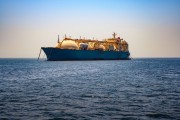If you’ve been paying attention to the debate over Northern Gateway or Keystone XL, you’ll notice public concern isn’t limited to oil spills. Whether it’s carbon pollution or tailings ponds, many people are also concerned about what new pipelines will mean for oilsands expansion and its associated impacts.
It’s the same for B.C.’s liquefied natural gas (LNG) plan. While the government has talked extensively about the liquefaction terminals proposed for the coast, it’s had much less to say about an expanded network of gas wells, pipelines, processing facilities and other equipment that will be needed to feed them.
 And the climate impact could be massive, depending on how much LNG is developed. If the scale matches the five to seven LNG terminals the province is counting on for its revenue and jobs projections, carbon pollution could be nearing that of the oilsands by 2020.
And the climate impact could be massive, depending on how much LNG is developed. If the scale matches the five to seven LNG terminals the province is counting on for its revenue and jobs projections, carbon pollution could be nearing that of the oilsands by 2020.
Fortunately those estimates aren’t fixed. They depend in large part on the technologies used along the supply chain. Here are a few options the province has for minimizing carbon pollution from LNG.
Well pads
At the well pad, the ground is drilled then fracked using fluid injected under high pressure to crack open shale rock and release trapped gas. A number of well pad operations result in carbon pollution, much of which can be avoided. For example, before the gas is directed into a pipeline it’s typically flared, producing carbon pollution.
Instead of flaring, gas can be captured and put directly into pipelines. B.C. currently doesn’t require this practice, but the Environmental Protection Agency is phasing in regulations that will require it for all gas wells in the U.S. by 2015.
Compressors
Energy is needed to compress gas and move it through pipelines. Industry’s standard practice is to burn gas to meet the energy needs for compressors, and for other processes along the supply chain. The carbon pollution from this practice accounts for half of the current total from B.C.’s gas sector.
Some operations in B.C. are using renewable electricity instead of burning gas and have reduced carbon pollution substantially. The Septimus electrification project and ARC Resources’ Dawson Creek Gas Plant are examples. Reproducing these types of projects across the supply chain is perhaps the most significant measure an LNG industry could take to minimize its carbon pollution.
Pipelines
Along pipelines there are a number of points where gas can leak. Referred to as “fugitive emissions,” these leaks consist predominantly of methane — a form of carbon pollution that’s 34 times more potent than carbon dioxide according to the Intergovernmental Panel on Climate Change. These leaks currently account for about 10 per cent of the carbon pollution from the province’s gas sector. But, with adequate monitoring and plans for fast repair, studies show that nearly 90 per cent of fugitive emissions can be avoided.
Processing facilities
When shale gas arrives at the processing facilities in northeast B.C., it contains carbon dioxide and other impurities. When those impurities are removed, carbon dioxide is vented to the atmosphere.
Capturing carbon dioxide and injecting it underground, i.e., carbon capture and storage (CCS), can help minimize this carbon pollution. This is an approach already being used for some LNG developments in Norway and Australia.
The province could also discourage drilling in areas with high levels of carbon dioxide. Of the two main gas basins in northeastern B.C., the Horn River near Fort Nelson contains more than ten times as much carbon dioxide than the Montney basin near Dawson Creek.
Pneumatic controllers
Pneumatic controllers use pressurized methane to control valves and monitor fluid levels, and then often vent it to the atmosphere. There are better options. Some controllers return vented methane back into pipelines after use. Others use compressed air (as ARC Resources has done in Dawson Creek). Remote solar powered controllers have also been available for almost a decade, but they haven’t received wide uptake because of the low price of gas.
Liquefaction terminals
Liquefaction terminals cool gas to a liquid state, requiring an enormous amount of energy to do so. That energy typically comes from burning gas. Alternatively, the energy could be supplied through a mix of local and grid-connected renewable energy sources. Analysis done by Clean Energy Canada found that maximizing renewable electricity could reduce carbon pollution by two-thirds compared to running liquefaction terminals entirely on gas.
Challenges and choices
As our new report illustrates, there are many technologies that can help minimize the climate impact from LNG. Identifying them, however, is only the first step — industry needs an incentive to use them. Many are more expensive than business as usual, and new technologies often introduce new challenges that aren’t always easy to overcome.
Take carbon capture and storage, for example. It’s a technology with an undeniably large potential to cut carbon pollution from B.C.’s gas sector. It would also require significant capital investment, and willingness from industry to adopt new ways of dealing with its wastes.
The right policies can provide reasons for industry to innovate. For example, B.C. could increase and broaden the carbon tax to give industry a stronger incentive to reduce carbon pollution. It could also require industry to pay into a technology fund that could help finance innovations along the LNG supply chain. Or it could set performance standards that set a limit on how much carbon pollution can be released for a given level of gas or LNG production.
Whatever policies the government adopts, it should consider the big picture. Minimizing the climate impact of an LNG boom will take a vision focused not only on liquefaction, or on fracking, but also on everything in between.




